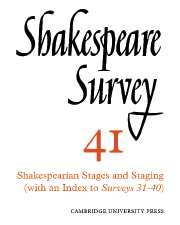Book contents
- Frontmatter
- The Shakespearian Stages, Forty Years On
- The Original Staging of The First Part of the Contention (1594)
- Charles Calvert’s Henry V
- Hamlet, An Apology for Actors, and The Sign of the Globe
- ‘Hid indeed within the centre’: The Hall/Finney Hamlet
- Malvolio and the Dark House
- The Text of Cressida and Every Ticklish Reader: Troilus and Cressida, The Greek Camp Scene
- Antony and Cleopatra, Act 4 Scene 16: ‘A Heavy Sight’
- The Tempest’s Tempest at Blackfriars
- Keats and Lucrece
- The Resources of Characterization in Othello
- Ovid and the Mature Tragedies: Metamorphosis in Othello and King Lear
- The Passing of King Lear
- Shakespeare Performances in London and Stratford-upon-Avon, 1986–7
- Professional Shakespeare Productions in the British Isles, January–December 1986
- The Year's Contributions to Shakespeare Studies: 1 Critical Studies
- 2 Shakespeare’s Life, Times, and Stage
- 3 Editions and Textual Studies
- Books Received
- Index to Volume 41
- General Index to Volumes 31-40
The Original Staging of The First Part of the Contention (1594)
Published online by Cambridge University Press: 28 March 2007
- Frontmatter
- The Shakespearian Stages, Forty Years On
- The Original Staging of The First Part of the Contention (1594)
- Charles Calvert’s Henry V
- Hamlet, An Apology for Actors, and The Sign of the Globe
- ‘Hid indeed within the centre’: The Hall/Finney Hamlet
- Malvolio and the Dark House
- The Text of Cressida and Every Ticklish Reader: Troilus and Cressida, The Greek Camp Scene
- Antony and Cleopatra, Act 4 Scene 16: ‘A Heavy Sight’
- The Tempest’s Tempest at Blackfriars
- Keats and Lucrece
- The Resources of Characterization in Othello
- Ovid and the Mature Tragedies: Metamorphosis in Othello and King Lear
- The Passing of King Lear
- Shakespeare Performances in London and Stratford-upon-Avon, 1986–7
- Professional Shakespeare Productions in the British Isles, January–December 1986
- The Year's Contributions to Shakespeare Studies: 1 Critical Studies
- 2 Shakespeare’s Life, Times, and Stage
- 3 Editions and Textual Studies
- Books Received
- Index to Volume 41
- General Index to Volumes 31-40
Summary
‘The usefulness of QI is . . . that it throws light on the theatrical and textual history of Shakespeare’s play. It suggests something of the performances . . . for which such a version was provided, and it tells us something of the performances which the actor-reporter had known . . . The stage directions indicate not what the author envisaged but what an actor remembered actually taking place.’ Though Harold Jenkins here has Hamlet in mind, his observation is valid of all reported texts. A reported text, or ‘bad quarto’, has as its textual authority not authorial copy, nor authorial copy adapted for use in the playhouse, but an actual production of the play, usually, we suppose, one which has been in performance for some time and has, therefore, been theatrically ‘broken in’. An ideal bad quarto would be one which reported with absolute accuracy not a promptbook or any other written document, but what was said and what happened on stage, just as an ideal printed text would be one which reproduced its copy with total fidelity. But this is not an ideal world: reported texts are all mediated not only by the circumstances of their printing, but also by the memories of their reporters. This is at once their theatrical advantage and their textual downfall. A reporter who witnessed – and probably took part in – the performance he reports will recall with sometimes only indifferent accuracy what he heard said, but he will also recall what he saw and what sounds he heard, and he may preserve some of these non-verbal recollections in his report.
- Type
- Chapter
- Information
- Shakespeare Survey , pp. 13 - 22Publisher: Cambridge University PressPrint publication year: 1989



